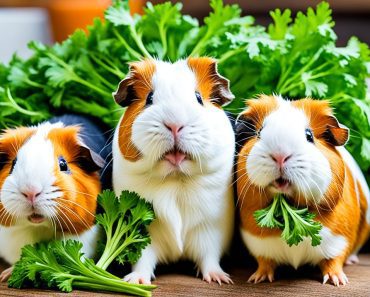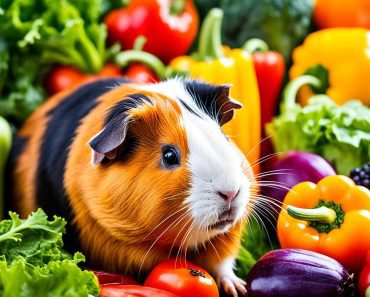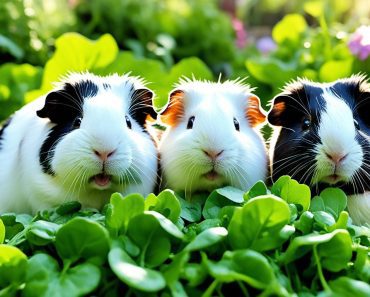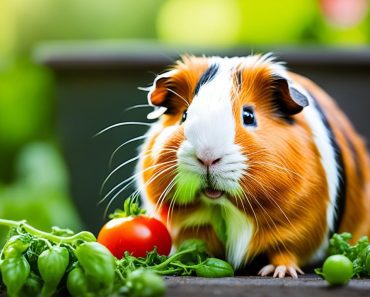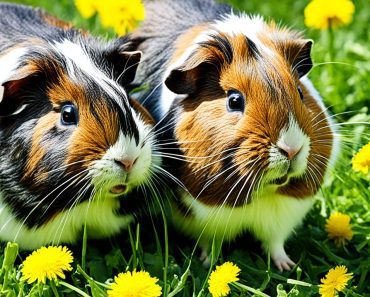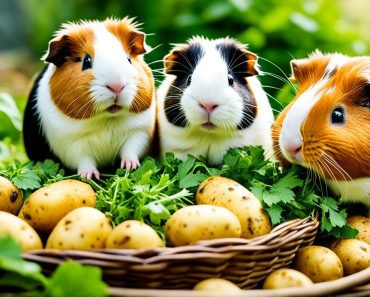Hello, fellow guinea pig enthusiasts! Today, I want to talk about a topic that often comes up when discussing our furry little friends – can guinea pigs eat grass? The answer is a resounding yes! In fact, it is not only safe for guinea pigs to eat grass, but it is also beneficial for their overall health and well-being.
Guinea pigs have a digestive system that is designed for lots of forage, which means they can munch on grass to their heart’s content. However, there are a few important things to keep in mind to ensure their safety and optimal nutrition.
First and foremost, it is crucial to provide them with safe grass for guinea pigs. Avoid offering grass that has been treated with pesticides or chemicals, as these can be harmful to their delicate systems. Additionally, grass clippings from lawn mowers should be avoided as they can ferment quickly and cause digestive issues.
To introduce fresh grass into your guinea pigs’ diet, it’s best to start gradually. Their digestive tract needs time to adjust to the new food. You can begin by offering small amounts and gradually increasing it as their system adapts.
Now, let’s delve into the benefits of grass for guinea pigs. Grass is an excellent source of essential fiber, which aids in digestion and helps prevent common health issues such as obesity, dental problems, and gastrointestinal disturbances.
Can Guinea Pigs Eat Grass? Yes, they can.
- Guinea pigs can safely eat grass, which is beneficial for their health.
- Ensure the grass is free from pesticides, chemicals, and animal waste.
- Introduce grass gradually to allow their digestive system to adjust.
- Grass provides essential fiber and helps prevent obesity, dental issues, and gastrointestinal problems.
- Grass hay should make up the majority of a guinea pig’s diet.
The Importance of Grass in a Guinea Pig’s Diet
When it comes to the diet of guinea pigs, grass plays a critical role in their overall health and well-being. In fact, grass hay should make up the majority of a guinea pig’s diet due to its numerous benefits. Let’s explore why grass is so essential for these adorable furry friends.
Fiber for Digestion and Prevention of Health Issues
Guinea pigs require a high-fiber diet to maintain a healthy digestive system and prevent various health issues, including obesity, dental problems, and gastrointestinal disorders.
Grass hay, such as timothy or orchard hay, is rich in fiber, making it an ideal staple for guinea pigs. Fiber aids in digestion by promoting proper gut motility and preventing the formation of hairballs and other obstructions. It also helps to wear down their continuously growing teeth and stimulates the production of saliva, which aids in digestion.
Constant Access and Quantity
To ensure a guinea pig’s health, it is important to provide constant access to grass hay and to include it in their diet in the right proportion.
Guinea pigs should have access to grass hay at all times, as it helps to keep their gut functioning properly and prevents boredom. In fact, grass hay should make up around 80% of their daily diet. This ensures that they receive the necessary fiber intake and helps to prevent overeating on other types of food, such as pellets or fruits. For younger guinea pigs, alfalfa hay can be provided as it contains more calcium for their growing bones.
The Benefits of Variety
Offering a variety of grass hays can provide additional nutritional benefits and make their diet more interesting.
While timothy and orchard hay are recommended as the primary types of grass hay, other options like meadow, brome, or oat hay can be included in their diet. This not only helps to promote a diverse nutrient profile but also keeps guinea pigs excited about their meals. Just like humans, guinea pigs enjoy having a variety in their diet.
Creating a Balanced Diet
Although grass hay is a crucial component of a guinea pig’s diet, it should be supplemented with other foods to create a well-rounded and nutritious meal plan.
Along with grass hay, guinea pigs should also be provided with timothy-based pellets fortified with vitamin C. These pellets help to support their immune system and prevent the development of scurvy, a common ailment in guinea pigs. Fresh vegetables, especially leafy greens like romaine lettuce, kale, and parsley, should also be incorporated into their diet. Additionally, small portions of fruits can be given as occasional treats.
| Essential Components of a Guinea Pig’s Diet | Recommended Quantity |
|---|---|
| Grass Hay (timothy or orchard hay) | 80% of their diet |
| Timothy-based Pellets (fortified with vitamin C) | 1/8 cup per day |
| Fresh Vegetables (leafy greens) | 2 cups per day |
| Fruits (occasional treat) | Small portions |
Providing a balanced diet ensures that guinea pigs receive all the necessary nutrients for their growth, well-being, and longevity.
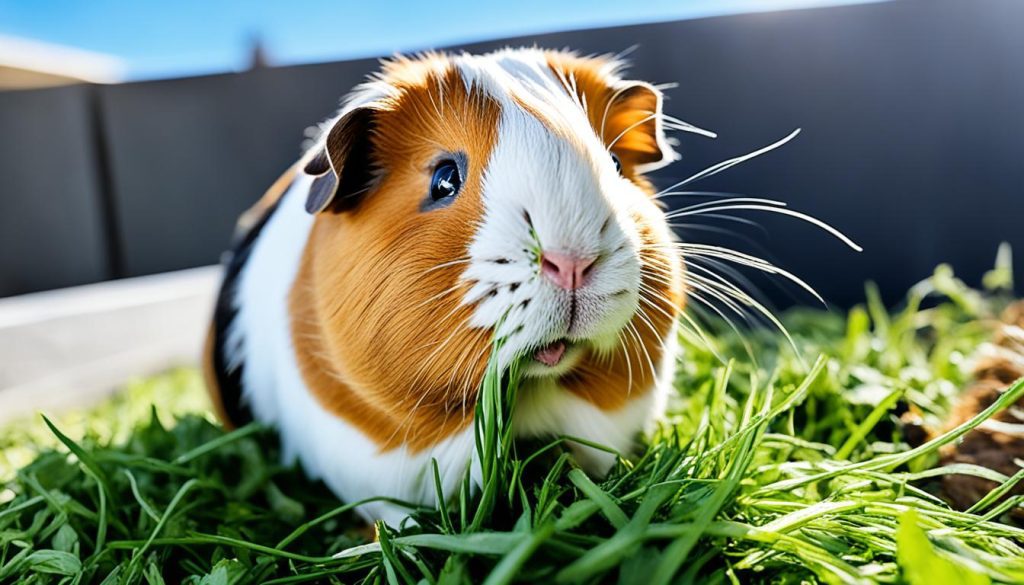
Other Components of a Guinea Pig’s Diet
While grass hay is an important component of a guinea pig’s diet, there are other elements that contribute to their overall nutrition and well-being. In addition to hay, guinea pigs should be fed pellets, fresh vegetables, and occasional fruit.
Pellets: Guinea pigs should be provided with timothy-based pellets that are fortified with vitamin C. These pellets serve as a supplemental source of essential nutrients. However, it’s important to note that pellets should only make up a small portion of their diet. A daily serving of about 1/8 cup of pellets is sufficient.
Fresh Vegetables: Leafy greens are an essential part of a guinea pig’s diet and should constitute the bulk of the vegetable portion. Options such as romaine lettuce, kale, and parsley are rich in vitamins and minerals. It’s important to offer a variety of fresh vegetables to ensure a well-rounded diet.
Fruit: While fruits are a tasty treat for guinea pigs, they should be given in moderation due to their sugar content. Berries, such as strawberries and blueberries, are suitable choices. Remember to remove any uneaten fruit to prevent spoilage.
By providing a balanced diet that includes grass hay, pellets, fresh vegetables, and occasional fruit, you can ensure that your guinea pig’s nutritional needs are met. Let’s take a closer look at how these components contribute to their health:
Nutritional Benefits of a Balanced Diet
A balanced diet ensures that guinea pigs receive all the essential nutrients they need for optimal health. Grass hay provides crucial fiber, while pellets and fresh vegetables deliver essential vitamins and minerals. The occasional fruit treat adds variety and enjoyment to their diet.
To help you visualize the importance of each component in a guinea pig’s diet, here’s a table summarizing their nutritional contributions:
| Component | Nutritional Contribution |
|---|---|
| Grass Hay | Fiber, essential for digestion and dental health |
| Pellets | Supplemental source of essential nutrients, fortified with vitamin C |
| Fresh Vegetables | Vitamins, minerals, and hydration |
| Fruit | Occasional treat, adds variety and enjoyment to their diet |
Ensuring a well-rounded and varied diet will support your guinea pig’s overall health and happiness. Remember to consult with a veterinarian to determine specific dietary requirements for your guinea pig based on their age, weight, and overall health.
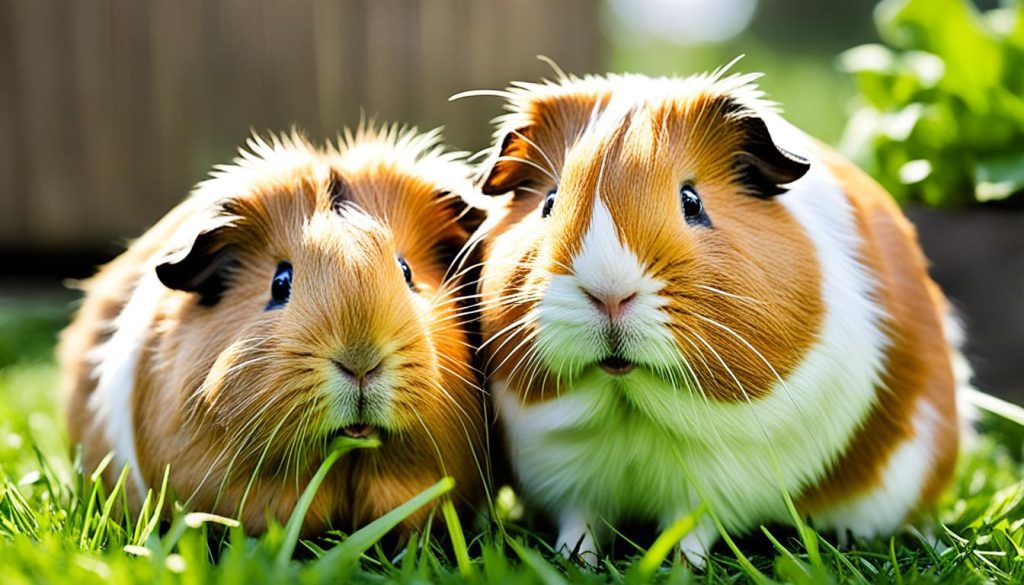
Considerations and Tips for Feeding Grass to Guinea Pigs
When it comes to feeding grass to guinea pigs, there are a few important considerations to keep in mind to ensure their health and well-being. Here are some tips to help you provide the best grass for your furry friends:
- Choose the Best Grass: Opt for fresh, organic grass that is free from pesticides, chemicals, and animal waste. This will help prevent any potential harm to your guinea pigs’ digestive system and overall health.
- Hand-Pull or Cut Grass: Avoid using grass clippings from mowers as they can ferment quickly and cause digestive issues in guinea pigs. Instead, hand-pull or cut the grass to provide your pets with fresh and safe options.
- Introduce Gradually: Guinea pigs’ digestive systems can be sensitive, so it’s important to introduce grass gradually. Start by offering a small amount and gradually increase it over time. This will allow their digestive tract to adjust and prevent any potential digestive upset.
- Provide Variety: Just like us, guinea pigs can benefit from a varied diet. Offer a variety of grasses, such as timothy, orchard, or meadow grass, to promote optimum health. This will provide them with different nutrients and flavors to enjoy.
By following these considerations and tips, you can provide your guinea pigs with the best grass for their diet, ensuring their overall health and happiness.
Testimonial
“I’ve always made sure to hand-cut fresh grass for my guinea pigs. It gives them something to nibble on throughout the day and they absolutely love it! Since I started incorporating different types of grass, they seem much more excited during feeding time. It’s definitely worth the effort!”
– Emily, Guinea Pig Owner
| Types of Grass | Nutritional Benefits |
|---|---|
| Timothy Grass | High in fiber and helps maintain dental health |
| Orchard Grass | Rich in essential nutrients like protein, calcium, and vitamin C |
| Meadow Grass | Provides a variety of nutrients and adds diversity to the diet |
Key Points for Feeding Guinea Pigs
When it comes to feeding your guinea pigs, there are some important points to keep in mind. By following these key guidelines, you can ensure that your furry little friends receive a well-rounded and nutritious diet. Here are the top considerations:
- Provide Unlimited Access to Grass Hay: Grass hay should make up around 80% of your guinea pig’s diet. Choose a safe grass variety, such as timothy hay or orchard grass, and make it readily available to your pets at all times.
- Offer Timothy-Based Pellets: Guinea pigs require pellets that are fortified with essential nutrients like vitamin C. Opt for timothy-based pellets and offer about 1/8 cup per day, adjusting the amount based on your guinea pig’s age, weight, and specific dietary needs.
- Include a Variety of Fresh Vegetables: Fresh vegetables are an important part of your guinea pig’s diet. Leafy greens like romaine lettuce, kale, and parsley should make up the bulk of the vegetable portion. Aim to provide a diverse range of vegetables to ensure your furry friend receives a wide array of nutrients.
- Limit Fruit Intake: While fruits can be a tasty and natural treat for guinea pigs, they should be given in moderation due to their high sugar content. Offer small portions of fruit as an occasional treat, and opt for guinea pig-friendly options like sliced apples, strawberries, or blueberries.
- Introduce Fresh Grass Gradually: Fresh grass can be a delightful addition to your guinea pig’s diet, but it should be introduced gradually. Ensure that the grass is safe and free from contaminants, and allow your guinea pigs to adjust to the new food gradually.
- Remove Uneaten Fresh Foods: To maintain cleanliness and prevent spoilage, promptly remove any uneaten fresh foods from your guinea pig’s enclosure. This ensures that they have access to fresh and safe foods at all times.
- Avoid Harmful Foods: Some foods are known to be harmful to guinea pigs and should be avoided. These include avocados, onions, and grapes. Always research and be mindful of the foods that can be toxic to your furry friends.
By following these key points, you can provide your guinea pigs with a well-balanced diet that includes safe grass, fresh vegetables, and occasional treats. Remember to consult with a veterinarian for specific dietary recommendations based on your guinea pig’s individual needs.
Conclusion
Incorporating grass into a guinea pig’s diet is not only safe but also highly beneficial for their overall health and well-being. Grass provides essential fiber and nutrients that aid in digestion and promote a healthy digestive system. It also helps prevent obesity, dental issues, and gastrointestinal problems in guinea pigs. Therefore, it is crucial to include grass as a part of their regular diet.
When feeding grass to guinea pigs, it is important to ensure that the grass is free from contaminants such as pesticides, chemicals, and animal waste. Additionally, the introduction of grass should be done gradually to allow their digestive system to adjust. By taking these precautions, you can ensure that your guinea pig enjoys the benefits of grass without any adverse effects.
Along with grass, a guinea pig’s diet should also consist of other essential components such as hay, pellets, fresh vegetables, and occasional fruit. This balanced diet provides the necessary nutrients for their overall health. By following these feeding tips and providing a well-rounded diet, you can ensure that your guinea pig stays healthy, happy, and thriving.

